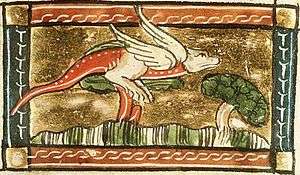Jaculus

The jaculus (or iaculus, pl. jaculi, meaning "thrown" in Latin) is a small mythical serpent or dragon. It can be shown with wings and sometimes has front legs. It is also sometimes known as the javelin snake.
In Greek mythology
It was said that the jaculus hid in the trees and sprang out at its victims. The force of it launching itself at the victim led to the association with javelins.[1] Pliny described it as follows: "The jaculus darts from the branches of trees; and it is not only to our feet that the serpent is formidable, for these fly through the air even, just as though they were hurled from an engine."[2]
Lucan also describes the attack of the jaculus in the Pharsalia. He explains that it is the wound caused by the jaculus hitting the victim that causes death. The jaculus does not kill with venom.
This is similar to one of the snakes of Madagascar, the fandrefiala, or tiny night snake.[3] It too, falls from a tree like a spear to stab animals, and is most feared by the locals. The fandrefiala snake is in fact known to modern science as Ithycyphus miniatus. It has V-shaped head markings which resemble a spearhead.
A jaculus is also found in the Old Norse romance Yngvars saga viðfǫrla. Here it is actually said to be an extremely large dragon (dreki). See Olson, Emil, ed. Yngvars saga viðfǫrla Jämte ett bihang om Ingvarsinskrifterna. Copenhagen: S. L. Møllers, 1912, p. 42.
In popular culture
- One of the units available in the 1999 turn-based strategy game Heroes of Might and Magic III from Fortress towns is the Jaculus-like Serpent Fly and its upgraded Dragon Fly form.
- Jaculi are briefly mentioned in Monsterology: The Complete Book of Fabulous Beasts, as Serpens volucer. Signs of the Jaculus are impaled prey, and pools of pink dung.
- In Yu-Gi-Oh! Trading Card Game, the monster "Mecha Phantom Beast Jaculuslan" is partly based on a Jaculus.
References
- ↑ Rose, Carol. (2000). Giants, Monsters and Dragons. Norton
- ↑ Pliny the Elder. The Natural History. Available at: http://www.perseus.tufts.edu/cgi-bin/ptext?doc=Perseus%3Atext%3A1999.02.0137&query=head%3D%23368 Retrieved Jul. 25, 2007
- ↑ Enigma: Madagascar's Mythical Creatures - http://www.travelafricamag.com/content/view/537/56/ Retrieved Apr. 23, 2007